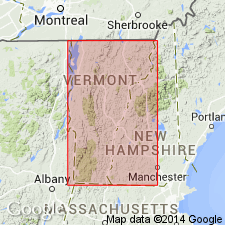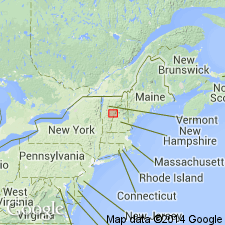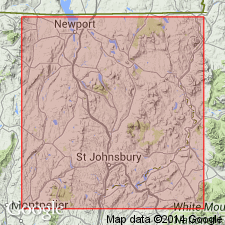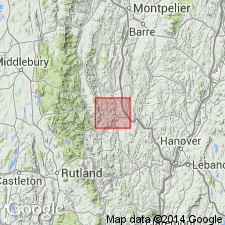
- Usage in publication:
-
- Bradford schist
- Modifications:
-
- Original reference
- Dominant lithology:
-
- Schist
- AAPG geologic province:
-
- New England province
Summary:
Pg. 295-296. Bradford schist. The noncalcareous member of Calciferous mica schist. Named from Bradford, [Mount Cube quadrangle], Orange Co., northeastern VT, where it predominates. The calcareous member is here named Washington limestone.
Source: US geologic names lexicon (USGS Bull. 896, p. 246-247).

- Usage in publication:
-
- Bradford schist
- Modifications:
-
- Overview
- AAPG geologic province:
-
- New England province
Summary:
Pg. 81. Bradford schist. Contains lower Trenton fossils. Was originally a sandstone, which is now represented by terranes of granular and micaceous quartzite and a foliated mica schist. Overlies black slate of Ordovician age. The Washington limestone is intimately interstratified with Bradford schist.
Source: US geologic names lexicon (USGS Bull. 896, p. 246-247).

- Usage in publication:
-
- Bradford schist
- Modifications:
-
- Revised
- AAPG geologic province:
-
- New England province
Summary:
Pg. 90, 115, footnote. Bradford schist. Includes all of the non-calcareous members of old "Calciferous Mica Schist." It therefore embraces the quartzite, staurolitic, actinolitic, amphibolitic, ottrelitic, graphitic, and garnetiferous phases lying between 2 large narrow belts of slate and shale, one on east near Connecticut River, the other on west passing through Newport and Montpelier to Barnard.
[USGS has adopted Vershire schist as substitute for Bradford schist (preoccupied). Washington limestone (preoccupied) is replaced with Waits River limestone.]
Source: US geologic names lexicon (USGS Bull. 896, p. 246-247).

- Usage in publication:
-
- Bradford schists
- Modifications:
-
- Revised
- AAPG geologic province:
-
- New England province
Summary:
Bradford schists, in Bradford Township, overlie Waits River limestone and are therefore younger than the phyllites here named Randolph phyllite.
Source: US geologic names lexicon (USGS Bull. 896, p. 246-247).
For more information, please contact Nancy Stamm, Geologic Names Committee Secretary.
Asterisk (*) indicates published by U.S. Geological Survey authors.
"No current usage" (†) implies that a name has been abandoned or has fallen into disuse. Former usage and, if known, replacement name given in parentheses ( ).
Slash (/) indicates name conflicts with nomenclatural guidelines (CSN, 1933; ACSN, 1961, 1970; NACSN, 1983, 2005, 2021). May be explained within brackets ([ ]).

